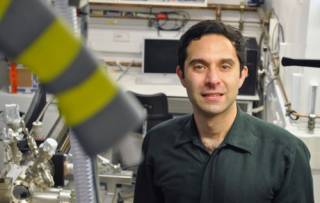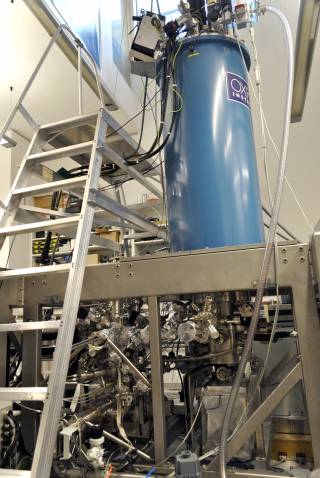Extending the life of the spin of single atoms
27 January 2014
Extending the life of the spin of single atoms
A single quantum spin, found in single atoms and molecules, is the smallest magnet available. The possibility to control the spin of single atoms is now intensively researched because they could serve as carriers of quantum information in future quantum computers. Also within reach is their use for storing ordinary binary information, and this would allow the increase of the density of magnetic data storage by orders of magnitude. However, unlike the magnetization of materials currently used for data storage, the spin of single atoms is often too short-lived for data storage or quantum computing because of their interaction with other nearby physical systems.
Now a team lead by Cyrus Hirjibehedin in the London Centre for Nanotechnology at UCL has set out to investigate whether it would be possible to control the interactions between single magnetic atoms and their surrounding structure so that their spins can survive longer. Their research was published in the journal Nature Nanotechnology.

“As a test we put down a material we understood pretty well, cobalt, to see if there was a difference,” says Hirjibehedin.
First the team located a number of cobalt atoms on a copper nitride island with a scanning tunneling microscope (STM). Then they selected various atoms, starting at the edge of the island and then at increasing distances from the edge. They hovered the STM tip over each of the selected atoms, applied a bias voltage that ranged from – 15 mV to 15 mV, and measured the differential conductance (the ratio of the change in current passing through the atom to the change in bias voltage for very small changes in bias voltage)–a technique called scanning tunneling spectroscopy (STS).

“In principle,” says Hirjibehedin, “you can have various strain effects near the edges, so we thought there might be something small, but we were quite surprised that what we saw was very dramatic.”
“What we found is that the interaction between the cobalt atom and the copper is much stronger near the edges than it is at the center,” he says.
An obvious explanation is that the insulating copper nitride layer played an important role in reducing the effect of the copper substrate on the spin of the single atoms. This interaction is known as Kondo exchange. If the atom with spin is close enough to the metal, its spin couples to the spins of the conduction electrons in the metal, causing these electrons to hop on and off the atom. An electron with opposite spin to the spin on the atom will hop onto the atom, and the other electron with opposite spin will hop off the atom. This process switches the spin of the atom up and down continuously, which makes data storage impossible.
Remarkably, the team also found that the same Kondo exchange that is responsible for this spin switching or “screening” also dramatically reduces the energy of the spin’s excitations, which also makes it less stable. This is significant because the excitation energy determines the spin’s stability, and normally this property is thought to be controlled by the surrounding physical structure rather than by electrical coupling.
It was clear to the team that near the edge of the island the Kondo exchange was strongly affecting the magnetic properties of the atom. What the team observed was that at the edges of the island, the Kondo effect was predominant, while more at the center the STS spectrum did not display this effect. This allowed them to correlate the change in the Kondo effect with the changes in the spin excitation energies. Two different calculations, performed by team members in Portugal and Germany, further support this explanation. “We use the Kondo effect as a sort of measurement for how strong this coupling is,” says Hirjibehedin, “and therefore how much it should affect the spin’s excitation energy.” He adds: “It still is an open question why the coupling is so much stronger at the edges of the island than in the middle.”
These new results suggest that tuning the electron density of a conducting material, as is often done in a field effect transistor, would enable the continuous tuning of the lifetime of the spins of nearby magnetic atoms. This could be done, for example, on a semiconductor substrate, which can be electrically gated to enhance or decrease the electron density. This would in turn affect the energies between the different spin states of nearby magnetic atoms, which would then modify the stability of the spins. “The stability of the spin is very important, in particular if you want to store data with a single atom,” concludes Hirjibehedin.
Related links
High-resolution image
Cyrus Hirjibehedin
Scanning tunneling microscope
This text and the photos associated with it are Creative Commons Attribution licensed, and so may be reproduced freely providing the credits are retained.
 Close
Close

